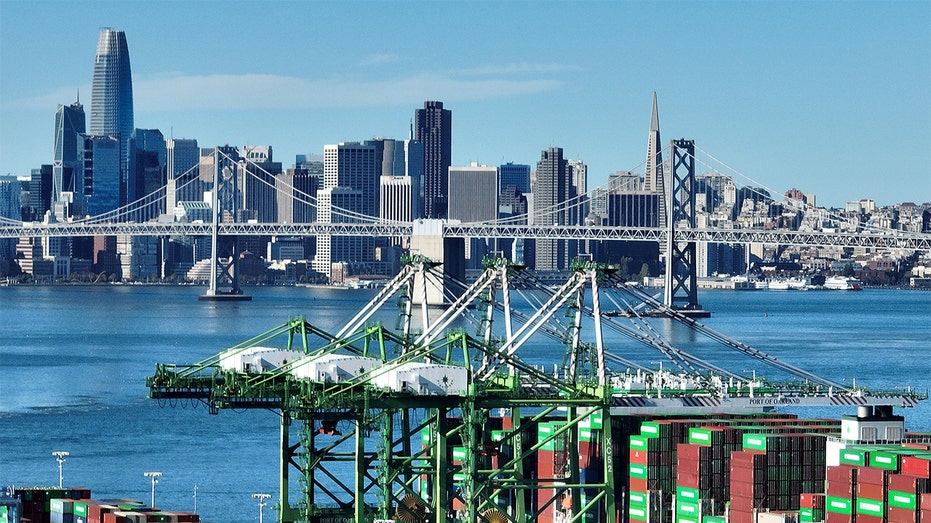Bullseye American Ingenuity Fund portfolio manager Adam Johnson discusses whether the stock market sell-off will last on Varney & Co.
The United States has the largest economy in the world, and each of its states and territories play a part in keeping its massive engine running. The states with the largest populations also contribute the most to gross domestic product, but a new study from WalletHub looked under the hood to gauge additional indicators of performance and strength.
The analysis released Monday compared all 50 states and the District of Columbia based on their economic activity, economic health, and innovation potential using 28 metrics, including change in GDP, unemployment rate and fiscal health, to determine which ones are pulling the most weight when it comes to moving the U.S. economy forward.
Here are the states with the best economies in the nation right now, according to WalletHub:
1. Washington
Arial view of Seattle, Washington. The state was named by WalletHub as best economy in the U.S. in 2024. ( / iStock)
The state of Washington topped the list with the highest economic activity ranking and an “extremely high” amount of industry R&D investment per capita, according to the findings.
INFLATION MEASURE CLOSELY WATCHED BY THE FED RISES 0.3% IN APRIL
“Washington claims the top spot as the best state economy, driven by substantial investment in research and development, a high concentration of high-tech jobs, and a robust startup ecosystem,” WalletHub analyst Cassandra Happe told FOX Business. “These factors position Washington as a current leader and a future powerhouse in economic growth and innovation.”
2. Utah
Utah’s economy was ranked No. 2 thanks to its impressive economic health and labor market, Happe said.
The Beehive State has the second-highest median annual household income in the nation after adjusting for the cost of living at nearly $84,000, and the average income in the state grew 6.8% between 2022 and 2023.
RISING NATIONAL DEBT TO REDUCE AMERICANS’ INCOME GROWTH: REPORT
Utah also has one of the lowest unemployment rates in the country, at 2.8%, along with the second-most growth in the civilian labor force.
3. Massachusetts

A view of the Boston skyline. Massachusetts was named third-best state economy in the country in a new WalletHub study. (Ron Dahlquist/Design Pics Editorial/Universal Images Group via / Getty Images)
Massachusetts was credited with having the third-best state economy, which Happe said was propelled by significant R&D investments and a strong presence in high-tech industries and STEM employment.
“The Bay State excels in innovation, with the highest share of high-tech jobs and a leading number of patents per capita,” Happe said. “These attributes make Massachusetts a key player in driving the national economy forward.”
4. Texas
In fourth place, Texas benefits from a diverse and large economy with significant GDP growth and strong export activity despite lower innovation potential, the analysis found.
HIGHER INTEREST RATES COULD COST US COMPANIES $380B IN ‘SLOWLY UNFOLDING CRISIS’
The Lone Star state’s economic activity index score was second-highest in the rankings, and it was seventh in economic health. But the state came in 24th for innovation potential.
5. California

Shipping cranes stand at the Port of Oakland in front of the San Francisco skyline on Oct. 24, 2022. (Justin Sullivan / Getty Images)
California landed the No. 5 spot for top state economies, which Happe said was reflective of “its role as a major economic powerhouse with numerous tech firms and substantial R&D investments.”
However, she said, the state faces challenges in economic health due to high living costs and income inequality.
US states with the worst economies
On the other end of the spectrum, Louisiana, ranking 47th, struggles with high unemployment rates and low median household income, with minimal R&D investment hampering its economic growth prospects, Happe said.
HOME INSURANCE RATES HAVE SURGED NEARLY 40% SINCE 2019 – BUT THEY’RE RISING FASTEST IN THESE STATES
Meanwhile, Arkansas, in 48th place, faces high poverty rates and limited high-tech job opportunities, impacting both economic health and innovation potential.
West Virginia was ranked 49th, which the study said was due to its declining labor force and low GDP growth, compounded by the lowest innovation potential in the country.

Charleston is the capital and largest city in West Virginia. ( / iStock)
Hawaii was listed as No. 50, and Mississippi came in dead last at No. 51 in the rankings. Happe said those two states are among those facing “significant economic challenges.”
Newsfromrss.com
The Aloha State, which relies heavily on tourism, is burdened with high state debt and a lack of growth in key economic areas, while Mississippi’s struggles were attributed to its low median household income, high poverty rate, and minimal entrepreneurial activity.


